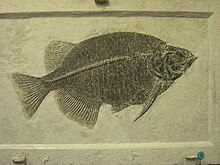Bone troll
| Bone troll | ||||||||||||
|---|---|---|---|---|---|---|---|---|---|---|---|---|

Red Arowana ( Scleropages legendrei ) |
||||||||||||
| Systematics | ||||||||||||
|
||||||||||||
| Scientific name | ||||||||||||
| Osteoglossidae | ||||||||||||
| Bonaparte , 1832 |
The family of osteoglossids (Osteoglossidae ( Gr .: osteon = bone, glossa = tongue)) are mostly large freshwater fish that live circumtropically in tropical South America , Southeast Asia , New Guinea and northern Australia . The animals stand out because of their large scales, have numerous primeval characteristics and are predatory fish or omnivores that can capture their prey, for example insects , while jumping.
features
Bone dwellers grow to be three to four feet long. They have an elongated, laterally flattened body. The mouth is large and sloping upwards. There are two barbels on the lower jaw . Along the lateral line organ they have 21 to 55 scales, the number of vertebrae is 60 to 100. The pelvic fins are supported by five to six fin rays and stand far behind the pectoral fins . Your maxillary is dentate. The number of Branchiostegal rays is 10 to 17.
Genera and species

There are two genera with seven and two types:
- Genus Scleropages Günther, 1864
- Subgenus Delsmania
- Golden arowana ( Scleropages aureus ) Pouyaud, Sudarto & Teugels, 2003
- Scleropages inscriptus Roberts, 2012
- Asian fork beard ( Scleropages formosus ) (Schlegel & Müller, 1844)
- Red Arowana ( Scleropages legendrei ) Pouyaud, Sudarto & Teugels, 2003
- Silver arowana ( Scleropages macrocephalus ) Pouyaud, Sudarto & Teugels, 2003
- Subgenus Scleropages
- Scleropages jardinii (Saville-Kent, 1892)
- Leichhardt's Knochenzüngler ( Scleropages leichardti ) (Günther, 1864)
- Subgenus Delsmania
- Genus Osteoglossum Cuvier, 1829
In his standard work on fish systematics, Fishes of the World , the American ichthyologist Nelson also counts the butterfly fish ( Pantodon buchholzi ), the arapaima ( Arapaima gigas ) and the African bone-wolf ( Heterotis niloticus ) to the family. The last two then form the subfamily Heterotidinae, the bone tongues in the sense the subfamily Osteoglossinae. In most of the other classifications, the butterflyfish, which probably occupies a basal position within the bone-winged species, is placed in a family of its own, the Pantodontidae. Arapaima and African bone-wolf form the family Arapaimidae , which is united with the Osteoglossidae to form the suborder Osteoglossoidei.
Phylogeny
The following cladogram shows the relationship between the individual species of bones, according to Pouyaud, Sudarto & Guy Teugels and the Arapaimidae as an outer group.
| Osteoglossoidei |
|
||||||||||||||||||||||||||||||||||||||||||||||||||||||
|
|

Fossil record
Some fossil taxa are also known. Brychaetus lived in the Paleocene and Eocene in Europe, North America and North Africa, Phareodus in the Eocene in North America and Australia.
literature
- Joseph S. Nelson : Fishes of the World. 4th edition. John Wiley & Sons, Hoboken NJ 2006, ISBN 0-471-25031-7 .
- Kurt Fiedler: Textbook of Special Zoology, Volume II, Part 2: Fish . Gustav Fischer Verlag, Jena 1991, ISBN 3-334-00339-6
- Laurent Pouyaud, Sudarto & Guy Teugels (December 2003): The Different Color Varieties of the Asian Arowana Scleropages formosus (Osteoglossidae) are distinct species: Morphologic and genetic evidences. Cybium 27 (4): 287-305. PDF
Individual evidence
- ^ Tyson R. Roberts (2012): Scleropages inscriptus , a new fish species from the Tananthayi or Tenasserim River basin, Malay Peninsula of Myanmar (Osteoglossidae: Osteoglossiformes). aqua, International Journal of Ichthyology, 18 (2): 113-118.
Web links
- Bonebreaker on Fishbase.org (English)